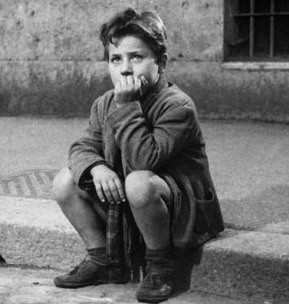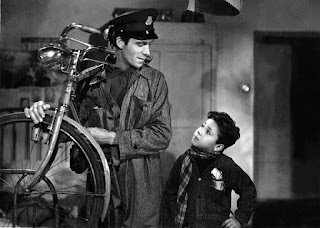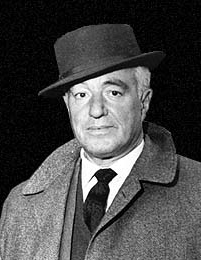Former Resistance fighter famous for neorealist classic Bitter Rice
 |
| Giuseppe De Santis used his films to highlight social problems in postwar Italy |
De Santis is sometimes described as an idealist of the neorealism genre, which flourished in the years immediately after World War Two, yet it can also be argued that he moved away from the documentary style that characterised some of neorealism’s early output towards films with more traditional storylines.
Bitter Rice, for example, while highlighting the harsh working conditions in the rice fields around Vercelli in the Po Valley and the exploitation of labourers by wealthy landowners, is also a tale of plotting, jealousy and treachery among thieves.
Nonetheless, De Santis, a staunch opponent of Mussolini and Fascism, an Italian Communist Party member who fought against the Germans with the Italian Resistance, inevitably underpinned his work with a strong social message.
The son of a surveyor, De Santis wrote stories from an early age, drawing on the day-to-day lives of the people around him in Fondi and the surrounding countryside. He enrolled to study literature and philosophy at university in Rome, making friends among the city’s young intellectuals, meeting poets, writers and artists who shared his vision. The Osteria Fratelli Menghi in Via Flaminia was a popular hang-out.
 |
| Luchino Visconti, with whom De Santis worked on Ossessione |
Despite their opposition to Fascism, De Santis and other anti-Fascists in the industry did not turn down the chance to take advantage of the facilities available at the CSC. At the same time, aware that a group of talented young directors could achieve his aims for the industry, Mussolini turned a blind eye to their political views, which some of the articles De Santis and others - including fellow future directors Antonio Pietrangeli, Luchino Visconti and Michelangelo Antonioni - wrote for the fortnightly Cinema magazine did not disguise.
While working for Cinema magazine, De Santis met the screenwriter Cesare Zavattini, under whose influence he became proponent of early neorealist filmmakers such as Visconti, who sought to make films that mirrored the reality of life for working-class Italians in the tough years of post-war rebuilding, shooting on location and giving parts to ordinary people with no acting experience.
De Santis, in fact, worked with Visconti on scripting the latter’s 1943 film Ossessione, a crime drama based loosely on the James M Cain novel The Postman Always Rings Twice, which the Fascists initially banned as morally corrupting.
His own directing debut came in 1947 with Caccia Tragica (Tragic Hunt), the first of three films protesting about conditions for working people that culminated in Riso Amaro, which starred the already-established Vittorio Gassman and the American actress Doris Dowling in the headline roles, with former footballer and journalist Raf Vallone making his debut.
It is remembered largely for the performance of Silvana Mangano, a voluptuous 19-year-old in her first credited part, who conveyed a combination of physical strength and earthy beauty that audiences and critics found entirely convincing in the role of a peasant worker accustomed to hours of slog in the rice fields, but still with the energy to dance the night away to her beloved boogie-woogie music. Mangano ultimately married the film’s producer, Dino De Laurentiis.
 |
| De Santis's Bitter Rice turned the previously unknown actress Silvana Mangano into a star |
De Santis made another important neorealist film three years later entitled Roma, ora 11 (Rome, 11 o’clock), a dramatic reconstruction of a real-life event in the Italian capital the previous year when a staircase collapsed under the weight of women queuing for job interviews, causing one death and multiple injuries.
In 1959 he won a Golden Globe with La strada lunga un anno (The Road a Year Long), which gained him another Oscar nomination for Best Foreign Language Film.
However, none of his subsequent work really had the same impact as Riso Amaro, which has been included on several subsequent lists of the best films in Italian cinema history.
De Santis directed his last feature film in 1972. He returned to the Centro Sperimentale di Cinematografia in the 1980s and ‘90s, this time in the role of lecturer. In 1995 he received the Golden Lion for Lifetime Achievement at the Venice Film Festival and came out of retirement to direct, jointly with Bruno Bigon, a documentary called Oggi è un altro giorno (Today is Another Day) - Milano 1945-1995, a documentary about the Resistance in Milan.
He died in Rome in 1997 at the age of 80, suffering a heart attack. A day of mourning was declared in Italy. His widow, Gordana Miletic, joined friends in establishing the Giuseppe De Santis Foundation, which gives an annual award in his memory to an emerging young film-maker.
 |
| The Castello Baronale, parts of which date back to the 12th century, stands proudly over Fondi |
Situated on the Via Appia, the former Roman road that was once the main route from Rome to much of southern Italy, the city of Fondi rarely features on tourist itineraries, yet travel guides often include the word charming, even enchanting, in their description. Situated on a small plain - il Piano di Fondi - between the Ausoni and Aurunci mountain ranges and the Tyrrhenian Sea, it was founded by the ancient Romans, it became an important commercial centre in mediaeval times, when the powerful Caetani family built the impressive Castello Baronale, which still dominates the skyline. Subsequently the home of the literary court of Giulia Gonzaga, in more recent times it has housed a museum. The Collegiata di Santa Maria Assunta,a beautiful Gothic-style church, is another attraction. The plain also benefits from a fine stretch of natural beach and Fondi has a tradition of excellent seafood.
Find accommodation in Fondi with Booking.com
 |
| An arch over the original Via Flaminia in Umbria |
The Osteria Fratelli Menghi, the historic tavern in Rome where De Santis would hang out with painters, actors, musicians and writers, was located in Via Flaminia on the site today occupied by the Caffè dei Pittori. The osteria was just 300m on foot from Piazza del Popolo, one of the major squares in the heart of Rome, yet there is much more to the Via Flaminia than simply a street in central Rome. It follows the route of the ancient Roman Via Flaminia, which was built by Gaius Flaminius in around 220 BC, going due north to cross the Tiber by way of the Ponte Milvio and continuing via a course over the Apennine Mountains to Ariminum (Rimini) on the coast of the Adriatic, a distance by the more recent of two routes of 328km (204 miles). The modern route from Rimini to Rome still follows closely the path of the original Roman road, a distance of 341km (), tracking the Adriatic coast to Fano, turning inland to pass close to Urbino, Perugia and Assisi and onwards towards the capital.
More reading:
Luchino Visconti - the aristocrat of Italian film
The enigmatic ‘last great’ of Italian cinema
The director known as the ‘father of neorealism’
Also on this day:
1791: The birth of architect Louis Visconti
1881: The birth of painter Carlo Carrà
1929: The Lateran Treaty gives independence to The Vatican
1948: The birth of footballer Carlo Sartori
1995: The birth of singer Gianluca Ginoble
(Picture credits: Via Flaminia by Imcarthur via Wikimedia Commons)




